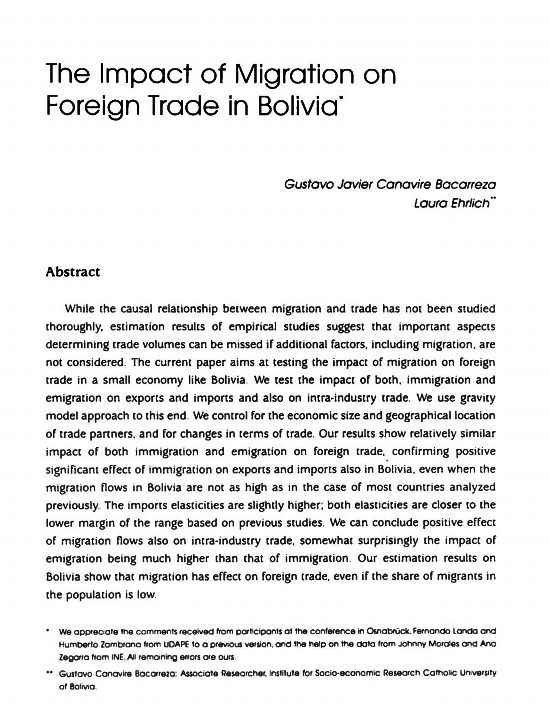The Impact of Migration on Foreign Trade in Bolivia
DOI:
https://doi.org/10.35319/lajed.20066246Keywords:
International Trade, MigrationAbstract
While the causal relationship between migration and trade has not been studied thoroughly, estimation results of empirical studies suggest that important aspects determining trade volumes can be missed if additional factors, including migration, are not considered. The current paper aims at testing the impact of migration on foreign trade in a small economy like Bolivia. We test the impact of both, immigration and emigration on exports and imports and also on intra-industry trade. We use gravity model approach to this end. We control for the economic size and geographical location of trade partners, and for changes in terms of trade. Our results show relatively similar impact of both immigration and emigration on foreign trade, confirming positive significant effect of immigration on exports and imports also in Bolivia, even when the migration flows in Bolivia are not as high as in the case of most countries analyzed previously. The imports elasticities are slightly higher, both elasticities are closer to the lower margin of the range based on previous studies. We can conclude positive effect of migration flows also on intra-industry trade, somewhat surprisingly the impact of emigration being much higher than that of immigration. Our estimation results on Bolivia show that migration has effect on foreign trade, even if the share of migrants in the population is low.
Downloads
References
Antelo, E. 2000. “Políticas de estabilización y de reformas estructurales en Bolivia a partir de 1985”. Comisión Económica para América Latina (CEPAL) Serie Reformas Económicas 62, Mayo.
Bergstrand, J. H. 1985. “The gravity equation in international trade: some microeconomic foundations and empirical evidence”. Review of Economics and Statistics, Number 67, 474-481.
Borkakoti, J. 1998. International Trade. Causes and Consequences. An Empirical and Theoretical Text. Macmillan Press LTD.
Combes, P.P., M. Lafourcade, and T. Mayer. 2003. “Can Business and social networks explain the border effect puzzle?”. CEPII Working Paper No. 2.
Dunlevy, J. A., and W. K. Hutchinson. 1999. “The Impact of Immigration on American Import Trade in the Late Nineteenth and Early Twentieth Centuries”. The Journal of Economic History, Vol. 59, Number 4, 1043-1062.
Dunlevy, J. A., and W. K. Hutchinson. 2001. “The pro-trade effects of immigration on American exports during the period 1870 to 1910”. Vandablit University Working Paper 01-W25.
Girma, S., and Z. Yu. 2000. “The link between immigration and trade: evidence from the UK Centre for the Research on Globalisation and Labour Markets (GLM)”. School of Economics, University of Nottingham, Research Paper, No. 23.
Globerman, S. 1995. “Immigration and Trade”. In: D.J. DeVoretz (ed.). Diminishing Returns: Canada's Recent Immigration Policy. C.D Howe and the Laurier Institution, Montreal.
Gould, D. M. 1994. “Immigrant Links to the Home Country: Empirical Implications for U.S. Bilateral Trade Flows”. The Review of Economics and Statistics. Vol. 76. No. 2 (May), 302-316.
Grubel, H. G., and P. J. Lloyd, 1975. Intra-Industry Trade: The Theory and Measurement of International Trade in Differentiated Products. New York: Wiley.
Head. K., and J. Ries, 1998. “Immigration and Trade Creation: Econometric Evidence from Canada” The Canadian Journal of Economics. Vol. 31, No 1 (Feb.), 47-62.
McCallum, J. 1995. “National borders matter: Canada-U.S. regional trade patterns”. American Economic Review 85, 615-623.
Ministry of Sustainable Development. 2004. “Aspectos de la población en Bolivia”. Population Policy Unit.
Morrison, T, K. 1982. “The Relationship of U.S Aid, Trade and Investment to Migration Pressures in Major Sending Countries”. International Migration Review, Vol. 16, No. 1 (Spring), 4-26
Parsons, C. 2005. “Quantifying the trade-migration nexus of the enlarged E. U. A. Comedy of Errors or Much Ado About Nothing?”. Sussex Centre for Migration Research. Sussex Migration. Working Paper No. 27.
Rauch, J. E., and V. Trindade, 2002. “Ethnic Chinese Networks in International Trade”. The Review of Economics and Statistics. February, Number 84 (1), 116-1 30.
Wagner, D., K. Head, and J. Ries. 2002. “Immigration and Trade in the Provinces” Scottish Journal of Political Economy. Vol. 49, No. 5, November.






